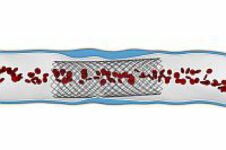Original title: Disability caused by multiple sclerosis is associated with the number of extra cranial venous stenoses: possible improvement by venous angioplasty. Results of a prospective study. Reference: M Denislic et al. Phlebology, doi: 10.1258/phleb.2012.012065. Multiple Sclerosis (MS) is considered a chronic inflammatory disease, progressive and immuno-mediated, demyelinating of the central nervous system. Its primary cause is still…
Strategies for treating left coronary trunk restenosis.
Original title: Clinical and Procedural Predictors of Suboptimal Outcome After the Treatment of Drug-Eluting Stent Restenosis in the Unprotected Distal Left Main Stem The Milan and New-Tokyo (MITO) Registry. Reference: Circ Cardiovasc Interv. 2012;5: 491-498 We have very little data on the percutaneous treatment of restenosis of an unprotected LMCA. The aim of this study was to evaluate…
Endovascular Repair of Abdominal Aorta, lower mortality rates than conventional open surgery in younger than 70.
Original title: Long Term Comparison of Endovascular and Repair of Abdominal Aortic Aneurysm (OVER TRIAL) Reference: Frank A. Lederle, et al. NEJM 367;24:1988-1997 Randomized studies had shown that the endovascular approach reduces mortality, yet its long term evolution remained a concern. The aim of this study was to analyze long term evolution of EVAR device implantation vs. conventional…
Future strategies to prevent restenosis and stent thrombosis
Original title: Endothelial cell repopulation after stenting determines in-stent neointima formation: effects of bare-metal vs. drug-eluting stents and genetic endothelial cell modification. Reference: Douglas G et al. European Heart Journal doi:10.1093/eurheartj/ehs240 Experimental models of vascular injury have shown that the rate of endothelial cell repopulation post-injury is a critical factor in determining subsequent neointima formation as well as…
Cilostazol reduces restenosis in infrapopliteal angioplasty
Original title: Impact of Cilostazol on Angiographic Restenosis after Balloon Angioplasty for Infrapopliteal Artery Disease in Patients with Critical Limb Ischemia Reference: Y. Soga et al. European Journal of Vascular and Endovascular Surgery 44 (2012) 577e581. Angioplasty is regularly used for patients with critical limb ischemia where restenosis is a great limitation, especially in infrapopliteal territory. The use…
Angioplasty for the erectile dysfunction
Original title: Zotarolimus-Eluting Peripheral Stents for the Treatment of Erectile Dysfunction in Subjects With Suboptimal Response to Phosphodiesterase-5 Inhibitors. Reference: Jason H. Rogers et al. J Am Coll Cardiol 2012. Article in press Up to 52% of men between 40 – 70 years old present some degree of erectile dysfunction, and 50% of these men get a suboptimal…
Complex angioplasty with ventricular assist
Original title: Real-Word of the Impella 2.5 Circulatory Support System in Complex High-Risk Percutaneous Coronary Intervention: The USpella Registry Reference: Brijeshwar maini, et al. Catheterization and Cardiovscular Intervention For about a decade angioplasty has begun to be performed in increasingly complex patients (PE) such as those with left coronary trunk injury, 3-vessel injury, poor ventricular function and surgically…
Risk Score for carotid angioplasty
Original title: Risk Prediction for Adverse Events After Carotid Artery Stenting in Higher Surgical Risk Patients Reference: Neil J. Wimmer et al. 2012;43: 3218-3224 Stroke. There are many patients with high surgical risk for carotid endarterectomy, either because of unfavorable anatomy, comorbidities or both. In this situation carotid angioplasty is a therapeutic option. However, no score has been…
High-dose atorvastatin for prevention of contrast nephropathy
Original title: Impact of a High Loading Dose of Atorvastatin on Contrast-Induced Acute Kidney Injury. Reference: Quintavalle et al. CIRCULATIONAHA.112.10331, 2012 Patients included in this study represent a subgroup with chronic renal failure (CRF) enrolled in the NAPLES II trial who were randomized to atorvastatin 80 mg 24 hours before angioplasty, (n = 202) versus the control group…
Risk score of thrombosis in patients with acute coronary syndrome
Original title: Development and Validation of a Stent Thrombosis Risk Score in Patients With Acute Coronary Syndromes. Reference: George D. Dangas et al. J Am Coll Cardiol Intv 2012;5:1097–105. The implantation of a stent in a pro thrombotic condition such as acute coronary syndrome (ACS) is associated with a higher incidence of stent thrombosis. There is no data…



